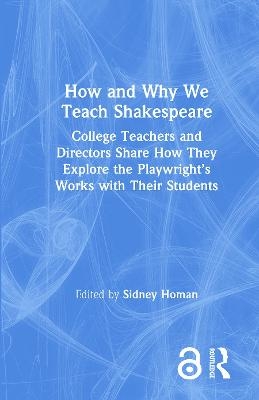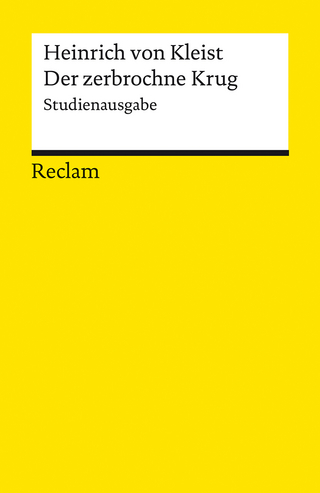
How and Why We Teach Shakespeare
Routledge (Verlag)
978-0-367-19079-8 (ISBN)
- Titel z.Zt. nicht lieferbar
- Versandkostenfrei
- Auch auf Rechnung
- Artikel merken
In How and Why We Teach Shakespeare, 19 distinguished college teachers and directors draw from their personal experiences and share their methods and the reasons why they teach Shakespeare. The collection is divided into four sections: studying the text as a script for performance; exploring Shakespeare by performing; implementing specific techniques for getting into the plays; and working in different classrooms and settings.
The contributors offer a rich variety of topics, including:
working with cues in Shakespeare, such as line and mid-line endings that lead to questions of interpretation
seeing Shakespeare’s stage directions and the Elizabethan playhouse itself as contributing to a play’s meaning
using the "gamified" learning model or cue-cards to get into the text
thinking of the classroom as a rehearsal
playing the Friar to a student’s Juliet in a production of Romeo and Juliet
teaching Shakespeare to inner-city students or in a country torn by political and social upheavals.
For fellow instructors of Shakespeare, the contributors address their own philosophies of teaching, the relation between scholarship and performance, and—perhaps most of all—why in this age the study of Shakespeare is so important.
Chapter 10 of this book is freely available as a downloadable Open Access PDF at http://www.taylorfrancis.com under a Creative Commons Attribution-Non Commercial-No Derivatives (CC-BY-NC-ND) 4.0 license.
Sidney Homan is Professor of English at the University of Florida and Visiting Professor at Jilin University in the People’s Republic of China. The recipient of many teaching awards, he was recently chosen as the Teacher/Scholar of the Year at the University of Florida. He is also a member of the Academy of Distinguished Teaching Scholars. Author of 16 books on Shakespeare and the modern playwrights, he is also an actor and director in professional and university theatres.
Introduction: How and Why
Sidney Homan
Section 1: Encountering Shakespeare’s Verbal and Visual Text with Students
1. Theatricality and the Resistance of Thesis
Andrew Hartley
2. ‘That’s a question: How shall we try it?’ (The Comedy of Errors 5.1)
Nick Hutchison
3. Re-Entering Macbeth: ‘Witches Vanish’ and Other Stage Directions
S. P. Cerasano
4. Seeing the Elizabethan Playhouse in Richard II
Joseph Candido
Section 2: Learning through Performance
5. Acting and Ownership in the Shakespeare Classroom
James Bulman and Beth Watkins
6. Performing Hamlet
Russell Jackson
7. ‘Gladly Would He Learn and Gladly Teach’: Empowering Students with Shakespeare
Sidney Homan
8. Uncertain Text: Student and Teacher Find Their Way Onstage in Romeo and Juliet
Jerry Harp and Erica Terpening
9. ‘In Practice Let Us Put It Presently’: Learning with Much Ado
Fran Teague and Kristin Kundert
Section 3: Approaching Shakespeare from Some Specific Angles
10. Shakespeeding into Macbeth and The Tempest: Teaching with the Shakespeare Reloaded Website
Liam Semler
11. ‘And so everyone according to his cue’: Practice-led Teaching and Cue-scripts in the Classroom
Miranda Fay Thomas
12. Collaborating with Shakespeare
Frederick Kiefer
13. Shakespeare without Print
Paul Menzer
Section 4: Shakespeare in Various Classrooms
14. That Depends: What Do You Want Two Plus Two To Be?
Cary Mazer
15. ‘Who's there?’ ‘Nay, answer me. Stand and unfold yourself’: Attending to Students in Diversified Settings
Naomi Conn Liebler
16. Unpicking the Turkish Tapestry: Teaching Shakespeare in Anatolia
Patrick Hart
17. Teaching Shakespeare to Retirees in the OLLI Program
Alan Dessen
Afterword: Cur Non?
June Schlueter
| Erscheinungsdatum | 24.07.2019 |
|---|---|
| Zusatzinfo | 2 Halftones, black and white; 2 Illustrations, black and white |
| Verlagsort | London |
| Sprache | englisch |
| Maße | 129 x 198 mm |
| Gewicht | 590 g |
| Themenwelt | Literatur ► Lyrik / Dramatik ► Dramatik / Theater |
| Kunst / Musik / Theater ► Theater / Ballett | |
| Geisteswissenschaften ► Sprach- / Literaturwissenschaft ► Anglistik / Amerikanistik | |
| Geisteswissenschaften ► Sprach- / Literaturwissenschaft ► Literaturgeschichte | |
| Geisteswissenschaften ► Sprach- / Literaturwissenschaft ► Literaturwissenschaft | |
| Sozialwissenschaften ► Pädagogik | |
| ISBN-10 | 0-367-19079-6 / 0367190796 |
| ISBN-13 | 978-0-367-19079-8 / 9780367190798 |
| Zustand | Neuware |
| Haben Sie eine Frage zum Produkt? |
aus dem Bereich


